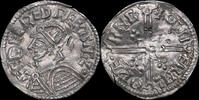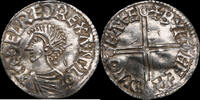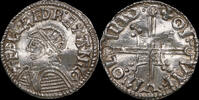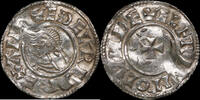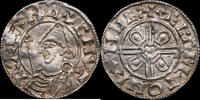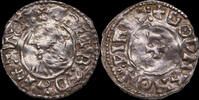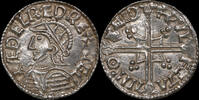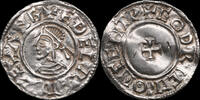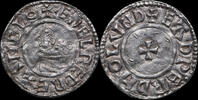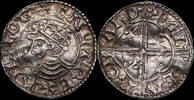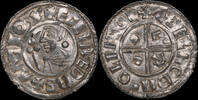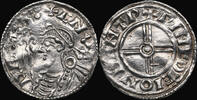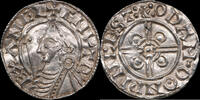MA-ID: 608902090
Customer feedback Numex OÜ
Excellent seller, highly recommended!
Thank You! Nice items for reasonable price, quick shipping! Excellent!!!
Ja, ich bin mit dem gekauften Geldschein vollig zufrieden. Danke.
M.Brindz...
Super Ware! Gerne wieder.
England / Lincoln penny Aethelred II (978-1016) Crux type, Æthelnoth UNC
Numex OÜ 

9
On MA-Shops since 9 years
1195 ratings,
100 % Positive (last 24 months)
Worldwide shipping
858.28 £990,00 EUR
Import tax may be added
+ 21.67 £ shipping ( to United Kingdom )
Delivery time: 11 - 14 days
+ 21.67 £ shipping ( to United Kingdom )
| Customer Support +49 (0)2871 2180 383 |
| Payment methods |
| Wire Transfer |
+ÆĐELRED REX ANGLOX
+ÆĐLNOĐ M-O LINCOL
Rare moneyer: Æthelnoth
Aethelred II's Lincoln Penny: The Crux Type
Aethelred II, often known as 'Aethelred the Unready', ruled England from 978 to 1013 and then briefly from 1014 to 1016. His reign was marked by constant threats from Viking invasions, internal political strife, and his attempts to manage these through economic policies, one of which included the issuance of various coin types.
Historical Context:
Aethelred II ascended to the throne at the tender age of twelve after his half-brother, Edward the Martyr, was killed. His epithet, "the Unready," derives from the Old English word "unræd," meaning "bad counsel" or "ill-advised," a play on his name Æthelred which means "noble counsel." His reign saw significant Viking incursions, leading to the payment of Danegeld, tribute paid to Vikings to prevent or stop their raids. These payments played a role in the economic policies of his time, influencing coinage production.
The Crux Penny:
The Crux type penny, issued around 991-997, is one of the most recognized coin types from Aethelred II's reign. The name "Crux" comes from the Latin word for "cross," which is prominently displayed on the coin's reverse:
Obverse: Features a left-facing bust of Aethelred, often described as bare-headed, though depictions might show him with a diadem. The inscription typically reads "+ÆÐELRÆD REX ANGLO," which translates to "Aethelred King of the English."
Reverse: Displays a short voided cross with the letters "CRUX" in the angles. This design was believed to have been introduced to call upon divine protection against the Viking raids, the cross being a potent Christian symbol of defense. The reverse legend usually indicates the moneyer and the mint, in this case, "XXX M-O LINCOLN" where "XXX" would be replaced by the moneyer's name, and "LINCOLN" specifies the mint location.
Numismatic Significance:
Production and Distribution: Lincoln was one of several mints in England where these pennies were struck, alongside major mints like London, Winchester, and York. The Crux type was part of Aethelred's policy of frequent coinage renewals, aiming to debase the currency periodically to generate revenue through the minting process.
Design and Quality: The quality of the coinage varied, but the Crux type is often praised for its design clarity, with a well-defined bust and clear inscriptions. This era saw a high standard in coinage production, partly due to these frequent recoinages.
Economic and Political Implications: The frequent changes in coin design were not just about aesthetics or divine protection but served economic ends. By recalling old currency and issuing new coins, Aethelred could control the money supply, address the circulation of debased coinage, and potentially profit from the minting process itself.
Rarity and Collectibility: While not extremely rare, the Lincoln Crux pennies are of interest to collectors due to their historical context, the variety of moneyers at Lincoln, and variations in die usage which can affect the coin's details and value in the numismatic community.
Conclusion:
The Lincoln penny of Aethelred II, particularly the Crux type, serves as a tangible piece of history, reflecting the political, economic, and religious challenges of late Anglo-Saxon England. It encapsulates the era's turmoil, Aethelred's attempts at governance through coinage, and the enduring legacy of his reign, remembered through the artifacts like these coins that have survived centuries.
+ÆĐLNOĐ M-O LINCOL
Rare moneyer: Æthelnoth
Aethelred II's Lincoln Penny: The Crux Type
Aethelred II, often known as 'Aethelred the Unready', ruled England from 978 to 1013 and then briefly from 1014 to 1016. His reign was marked by constant threats from Viking invasions, internal political strife, and his attempts to manage these through economic policies, one of which included the issuance of various coin types.
Historical Context:
Aethelred II ascended to the throne at the tender age of twelve after his half-brother, Edward the Martyr, was killed. His epithet, "the Unready," derives from the Old English word "unræd," meaning "bad counsel" or "ill-advised," a play on his name Æthelred which means "noble counsel." His reign saw significant Viking incursions, leading to the payment of Danegeld, tribute paid to Vikings to prevent or stop their raids. These payments played a role in the economic policies of his time, influencing coinage production.
The Crux Penny:
The Crux type penny, issued around 991-997, is one of the most recognized coin types from Aethelred II's reign. The name "Crux" comes from the Latin word for "cross," which is prominently displayed on the coin's reverse:
Obverse: Features a left-facing bust of Aethelred, often described as bare-headed, though depictions might show him with a diadem. The inscription typically reads "+ÆÐELRÆD REX ANGLO," which translates to "Aethelred King of the English."
Reverse: Displays a short voided cross with the letters "CRUX" in the angles. This design was believed to have been introduced to call upon divine protection against the Viking raids, the cross being a potent Christian symbol of defense. The reverse legend usually indicates the moneyer and the mint, in this case, "XXX M-O LINCOLN" where "XXX" would be replaced by the moneyer's name, and "LINCOLN" specifies the mint location.
Numismatic Significance:
Production and Distribution: Lincoln was one of several mints in England where these pennies were struck, alongside major mints like London, Winchester, and York. The Crux type was part of Aethelred's policy of frequent coinage renewals, aiming to debase the currency periodically to generate revenue through the minting process.
Design and Quality: The quality of the coinage varied, but the Crux type is often praised for its design clarity, with a well-defined bust and clear inscriptions. This era saw a high standard in coinage production, partly due to these frequent recoinages.
Economic and Political Implications: The frequent changes in coin design were not just about aesthetics or divine protection but served economic ends. By recalling old currency and issuing new coins, Aethelred could control the money supply, address the circulation of debased coinage, and potentially profit from the minting process itself.
Rarity and Collectibility: While not extremely rare, the Lincoln Crux pennies are of interest to collectors due to their historical context, the variety of moneyers at Lincoln, and variations in die usage which can affect the coin's details and value in the numismatic community.
Conclusion:
The Lincoln penny of Aethelred II, particularly the Crux type, serves as a tangible piece of history, reflecting the political, economic, and religious challenges of late Anglo-Saxon England. It encapsulates the era's turmoil, Aethelred's attempts at governance through coinage, and the enduring legacy of his reign, remembered through the artifacts like these coins that have survived centuries.
Info / FAQ
| Shipping fees | ||||
|---|---|---|---|---|
| 0.87 £ to 43.35 £ | 43.35 £ to 173.39 £ | 173.39 £ to 433.48 £ | over 433.48 £ | |
| China | 10.40 £ | n/a | n/a | n/a |
| Germany | 4.33 £ | 4.33 £ | 4.33 £ | 13.00 £ |
| Estonia | 4.33 £ | 4.33 £ | 4.33 £ | 10.40 £ |
| United Kingdom | 4.33 £ | 4.33 £ | 4.33 £ | 21.67 £ |
| United States | 4.33 £ | 4.33 £ | 4.33 £ | 34.68 £ |
| European Union | 4.33 £ | 4.33 £ | 4.33 £ | 21.67 £ |
| World | 10.40 £ | 13.00 £ | 86.70 £ | 86.70 £ |
Information
Online orders are welcome as always and will be shipped directly.
|
Seller Home | 0Shopping cart | Terms of sale | Contact | MA Terms of sale | Privacy policy | Warranty | MA-Shops New Items Copyright ® 2001-2025, MA-SHOPS Coins All Rights Reserved. Designated trademarks and brands are the property of their respective owners. |
 Buy coins with warranty
Buy coins with warranty




